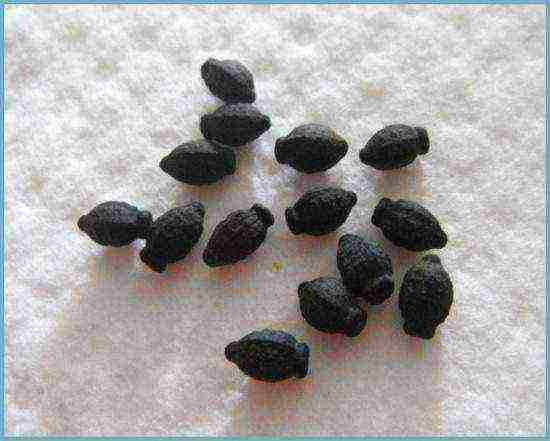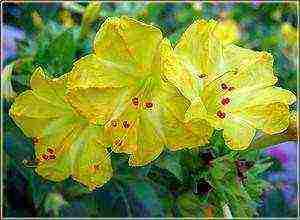Content
- 1 Description of the flower and methods of growing
- 2 Planting Mirabalis in the open field
- 3 Night beauty care rules
- 4 An annual, or? ..
- 5 Seeds for seedlings
- 6 Which container is better
- 7 Outdoor Landing - When Weather Permits
- 8 Unpopular grafting method
- 9 Soil for "beauty"
- 10 Sun, wind, drafts ...
- 11 Caring for their majesty the royal beard
- 12 Flowering period
 Mirabilis, aka "night beauty" - a herbaceous plant of the Niktaginov family, is considered a non-wintering perennial. The homeland of this unusual flower is Mexico and the southern part of America. In Florida, it grows in the open field in the wild.
Mirabilis, aka "night beauty" - a herbaceous plant of the Niktaginov family, is considered a non-wintering perennial. The homeland of this unusual flower is Mexico and the southern part of America. In Florida, it grows in the open field in the wild.
Mirabilis is a thermophilic plant, it will be an excellent option if planting and caring for green spaces is a burden for you. It got its interesting name due to an unusual property - the flowers of the plant bloom in the afternoon and smell fragrant all night long. Flowers wither by morning. Although a perennial plant is an exotic flower, growing it is a pleasure.
Mirabilis: varieties and varieties of "Night Beauty"
Mirabilis is not a frequent visitor to garden plots in Russia. However, about 60 varieties of this flowering plant are known in the world. And only one species took root in the middle latitudes of our country - Mirabilis Yalapa.

Mirabilis Yalapa
Mirabilis Yalapa (aka Mirabilis laxative) - a plant native to Mexico, is considered perennial, although it is cultivated as an annual. This is due to the fact that the roots of the plant are not ready for wintering in harsh conditions. The peculiarity of the "Night Beauty" is that sometimes buds of various shades can bloom on one stem. It grows to a height of 70–80 cm. Stems are straight, leaves are elongated, ovoid. The seeds of the plant have good germination, they retain their quality for 3 years.
Among the varieties of mirabilis yalapa, "Tea Time Formula Mixture" and "Tea Time Red" are especially distinguished. One of them has flowers of various shades, and the second, respectively, pink-red.
Mirabilis: planting and caring for the plant
Mirabilis is a light and heat-loving plant, therefore, when choosing a place for planting, you should give preference to the most illuminated and warm part of the garden.
Advice. "Night Beauty" prefers fertile loamy soils, this must be taken into account when planting.
Watering the plant should be moderate, no more than once every three days (preferably in the evening), after the soil dries out. But this perennial also does not tolerate drought. In the absence of watering, the growth of the flower stops.

Prevent the soil from drying out
In the southern latitudes of Russia, the planting of mirabilis in open ground is carried out already in April.
Features and stages of sowing perennials:
- sowing plant seeds in pots with peat at home;
- choose deep pots for sowing, since the root system of mirabilis grows deeper;
- preliminary soaking of the seeds is not required, the main thing is to carefully shed the soil in the pot;
- after 7-10 days the first shoots appear, and with good watering they turn into bushes;
- planting mirabilis in open ground.
In leaving, "Night Beauty" is unpretentious. The presence of good lighting, fertile soil and periodic moderate watering are the main conditions for growing an exotic perennial.

Seedlings of mirabilis
The plant is not afraid of drafts, even strong gusts of wind are not able to damage its thick and durable stem.
Advice.With the onset of cold weather, the tubers should be dug up and stored cool in winter, but at a temperature not lower than -5 degrees.
In the South of America, mirabilis grows like a wild plant, it does not require planting and personal care.
Fertilizing and feeding perennials
Before planting mirabilis in open ground, the soil must be limed. This is done by adding wood ash and mineral fertilizers to it.

Mirabilis can be fed with mineral fertilizers
During the summer period, perennials are additionally fed about 3 more times with mineral fertilizers.
The result will not be long in coming. The plant produces more buds, becomes more luxuriant and, as a result, more beautiful.
Reproduction of mirabilis
Plant propagation occurs in two well-known ways.
- By sowing seeds. Mirabilis seeds have good germination. Therefore, sowing is the main breeding method for this plant.
- Cuttings are a less popular way of propagating mirabilis. Nevertheless, it is also sometimes used. This option requires more effort and does not guarantee a positive result.

Mirabilis seeds
Instructions propagation of mirabilis by cuttings:
- cut dry branches from the plant;
- dry the place where the cut was;
- leave the cuttings in a growth promoter;
- after a few weeks, plant the cuttings in the prepared substrate.
If you follow the instructions step by step, then rooting will occur within 2 weeks.

Also, the plant is easy to propagate by cuttings.
Diseases and pests
Mirabilis, unlike most plants, is resistant to many diseases. Sometimes rust and mottling appear on it. A fungicide will help to cope with these unpleasant ailments. The rest of the cultivation of perennials will not be a problem.
Compositions with other plants
Mirabilis looks great in group compositions. Chamomiles, marigolds, bells and anemones are suitable as a combination with this exotic plant. Mirabilis also goes well with scented tobacco, lavender and lobularia.

Mirabilis in the garden
Depending on the variety of mirabilis, it is used in landscape design. Tall perennials are suitable as hedges. The lower ones are seated in groups, they are used to decorate curbs, mixborders and lawns are decorated.
Mirabilis is also suitable for decorating terraces and balconies, and lower specimens are planted in pots. An incredibly beautiful perennial in a single planting. It expands to occupy a large space.
Mirabilis is an unpretentious perennial plant. Some of its varieties are used for food or make paint from them. It is used in cosmetology and perfumery. It is widely used in landscape design, it looks great as a separate planting, as well as in combination with other plants. The ease of growing and caring for it attracts many gardeners. And the captivating and heady aroma that envelops everything in the night will not leave anyone indifferent.
Mirabilis care and cultivation: video
Types and varieties of mirabilis: photo







 The flowering plant, the night beauty, is increasingly conquering the corners of the gardeners' plots. This plant fell in love with the fact that it is distinguished by its hardiness to weather conditions, it tolerates drought well and at the same time is not demanding on the soil.
The flowering plant, the night beauty, is increasingly conquering the corners of the gardeners' plots. This plant fell in love with the fact that it is distinguished by its hardiness to weather conditions, it tolerates drought well and at the same time is not demanding on the soil.
This is a fairly tall plant with a lot of straight shoots and beautiful bright flowers, the cultivation of which does not require special skills.
Description of the flower and methods of growing
 Night beauty, or Mirabilis Yalapa, a native of South America, or rather, from Mexico, was brought to Europe in the middle of the 18th century.
Night beauty, or Mirabilis Yalapa, a native of South America, or rather, from Mexico, was brought to Europe in the middle of the 18th century.
A distinctive feature of the night beauty is herself bud opening phase, it blooms in the evening hours and at night, while a unique aroma is spread throughout the entire district.
However, it is not recommended to plant these plants in the areas of those who have allergies or intolerance to strong aromas.It is grown in two ways, by sowing seeds or planting tubers. It has a large number of colors, while on one bush there can be up to 5 different color colors of the buds.
Types of night beauty flower or mirabalis
- Multi-flowered.
- Terry.
- Tall.
- Stunted.
Plants on which flowers have a color that goes from almost black to white buds look most impressive. There are also varieties of peduncles that have striped or iridescent.
There are two ways how to grow a night beauty on your personal plot:
- seeds;
- tubers.
Growing seedlings of a night beauty from seeds
 If you want to grow mirabilis on your plot, growing from seeds is one of the possible ways. Sowing is done late March, early April, and in the regions of Siberia and the Far East, it is best to sow in early March.
If you want to grow mirabilis on your plot, growing from seeds is one of the possible ways. Sowing is done late March, early April, and in the regions of Siberia and the Far East, it is best to sow in early March.
In this case, you can be sure that the plant will fully develop and delight you with a riot of color. Before sowing, the seeds should soak for a day in warm water. This is done to soften the hard shell after being saturated with water.
The land for sowing seeds can be taken universal, the plant is not too demanding. Seeds deepening into damp ground 0.5 cm and spill with warm water again. The container with the sown seeds is covered with glass or foil and placed in a warm place.
After 2 weeks, the first shoots appear. The shelter is removed and the plants are placed on a light-colored windowsill. In the phase of the first true leaves of mirabilis dive into separate cups and make sure that the soil does not dry out.
On warm spring days, young mirabilis can be taken out into the fresh air for hardening. They should be planted in open ground when the threat of frost has passed. Disembarkation is best done in rainy weather, then the plants will quickly take root in a permanent place of growth.
Growing from tubers
 Store-bought tubers in winter are best stored in the refrigerator on the vegetable shelf before planting.
Store-bought tubers in winter are best stored in the refrigerator on the vegetable shelf before planting.
Night beauty tubers can be planted in open ground when the soil warms up to a depth of 10-15 centimeters, somewhere around mid-April, early May.
If sufficiently large sprouts have already appeared on the tubers of mirabilis, then the flowers should be at night cover with plastic bottles or non-woven fabric.
After the period of night frosts has passed, the shelter is removed and the plant is given complete freedom of growth. However, if the shoots of mirabilis are too long and weak, they should be pinched, leaving no more than 10 centimeters.
Planting Mirabalis in the open field
 The soil for a night beauty should not be too acidic. It's best if it will clay or loamy soil... On the site intended for planting mirabilis, there should be a sufficient amount of light, since in the shade or partial shade the plant does not bloom well and stretch.
The soil for a night beauty should not be too acidic. It's best if it will clay or loamy soil... On the site intended for planting mirabilis, there should be a sufficient amount of light, since in the shade or partial shade the plant does not bloom well and stretch.
Mirabilis is an aggressive plant and can displace neighbors in the flowerbed, so planting should take place on spacious plots or by the fence, thus forming a hedge.
However, there are also undersized varieties this flower, the cultivation of which can be carried out in pots or planted to frame flower beds, rockeries, borders. Low-growing varieties of mirabilis look good in the neighborhood with the following types of flowers:
- Tall roses.
- Delphiniums.
- Peonies.
Mirabilis, planting and caring in the open field for which does not require special skills, lends itself very well to shaping.
It can be pinch, trim, while flowering will only intensify. Shoots formed by cutting the stems in the form of a ball or pyramid look beautiful, since they are all instantly covered with flowers and become fully blooming.
Night beauty care rules
 On hot days, a night beauty should be irrigated with water in the evening, while watering should be carried out every 3-4 days... From an excess of moisture, the plant can stretch out and stop blooming.
On hot days, a night beauty should be irrigated with water in the evening, while watering should be carried out every 3-4 days... From an excess of moisture, the plant can stretch out and stop blooming.
Top dressing is carried out once a month, and mirabilis loves organic fertilizers, so it is best to apply to the root zone mullein or bird droppings... If there are no natural organic fertilizers, then you can dilute the humate infusion and spill the root zone.
Since the night beauty is a perennial plant, in the fall after the first frost, all green shoots should be cut off at a level of 10 centimeters from the ground and allowed to dry well, then dig out the rhizomes, dry in the sun and put in boxes, covering with dry sand or sawdust. You must not forget about it, this is part of leaving.
Store, like other nodule plants, in a basement at a temperature not lower than +5 degrees. Care must be taken to ensure that mirabilis flowers do not grow too early, and when buds of growth appear in the winter months transfer the tubers to the refrigerator.
However, in the southern regions of our country, the night beauty winters excellently in the soil, you just need to cut off the shoots and mulch the soil with straw or sawdust.
Growing a night beauty is not difficult. With proper care, every gardener will be able to grow on his site a beautiful plant with a large number of bright colors and an indescribable aroma, to the envy of everyone around. And even at night to delight your eyes with a beautiful view of a blooming area.
 Mirabilis flower or Night beauty belongs to the Niktaginov family. It occurs naturally in tropical and temperate regions of South and North America.
Mirabilis flower or Night beauty belongs to the Niktaginov family. It occurs naturally in tropical and temperate regions of South and North America.
Mirabilis got its second name due to the fact that its flowers are closed during the day, and they open and show their beauty only in the evening, in the morning they close again. In cloudy weather, the buds can be opened during the day.
With proper planting and good care, an unpretentious plant blooms for a long time, decorating garden and summer cottages with its beautiful and fragrant flowers.
Mirabilis flower - description
 Night beauty is a perennial plant, which is grown in the garden as an annual.
Night beauty is a perennial plant, which is grown in the garden as an annual.
Round-shaped bushes grow in height from thirty to eighty centimeters. They have tuberous swollen roots, reddish, densely branched, erect stems and green, entire, oblong-ovate, petioled leaves.
Funnel-shaped flowers of purple, yellow, orange, violet, crimson, white or bright red in diameter reach twenty-five millimeters. But the flowers of the Night Beauty can be not only monochromatic, there are varieties with two- or even tricolor buds... Flowers of different colors can form and bloom on one bush. After flowering, dark brown single-seeded large fruits with sharp ribs ripen on the bushes. If they are collected and dried, then the seeds will retain their germination for three years.
Types and varieties
About sixty species of mirabilis grow in nature. But in culture, mirabilis Yalapa is most often grown, on the basis of which many beautiful varieties have been bred by breeders.
Mirabilis Yalapa
 The plant is between thirty and eighty centimeters high and is distinguished by highly branched erect shoots, which are covered with bright green large leaves. In early summer, corymbose inflorescences are formed on the stems, consisting of funnel-shaped flowers of red, yellow, white or pink. Popular varieties:
The plant is between thirty and eighty centimeters high and is distinguished by highly branched erect shoots, which are covered with bright green large leaves. In early summer, corymbose inflorescences are formed on the stems, consisting of funnel-shaped flowers of red, yellow, white or pink. Popular varieties:
- Tee Time Red - variety with deep pink flowers, dark green oval-oblong leaves and very branched stems.
- Elvira - a dense, medium-sized bush with bright, rather large flowers, oblong, dark green leaves and smooth branchy stems.
- Red lollipop - a plant up to eighty centimeters high is distinguished by light green stems branched in the upper part, oval leaves wavy at the edges and bright red funnel-shaped flowers.
- Iolanta - a small bush up to fifty centimeters high from the end of June until frost blooms with bright flowers, the corolla of which is decorated with stripes-strokes.
Growing mirabilis from seeds
 The night beauty can be grown in a seedling and non-seedling way, but in any case, you must first prepare the planting material.
The night beauty can be grown in a seedling and non-seedling way, but in any case, you must first prepare the planting material.
To do this, rub the hard shell of the seeds with sandpaper or a file, then hold them in a thermos with warm water for a day.
Landing in open ground
In late April or early May, seeds are sown in flower beds with fertile or loamy soil. If the soil is acidic, then lime it before planting. It is not recommended to grow mirabilis on wet soils and in lowlands, as it does not like excess moisture.
Before sowing, grooves are made on a dug-up bed with a distance of seven to eight centimeters from each other. The seeds are buried to a depth of three centimeters, sprinkled with earth and poured with warm water from a watering can with a shower head. From above, the crops are covered with a film or non-woven material. When shoots appear and the threat of frost has passed, the shelter is removed, and the shoots are thinned out.
Growing seedlings
 To grow mirabilis from seeds at home, sowing seeds is done in early or mid-April. It is necessary to prepare a slightly alkaline or neutral light soil by mixing for this:
To grow mirabilis from seeds at home, sowing seeds is done in early or mid-April. It is necessary to prepare a slightly alkaline or neutral light soil by mixing for this:
- compost or humus - 1 part;
- peat - 2 parts;
- sod land - 2 parts;
- washed sand - ½ part.
In every five liters of the resulting soil mixture, add two tablespoons of dolomite flour or half a glass of ash.
The ¾ volume cups prepared for planting seeds are filled with a substrate, which must be watered with a solution of any fungicidal preparation. Place two seeds in wet soil and sprinkle them with a soil mixture with a layer of one and a half centimeters. Planting from above is sprayed with warm water from a spray bottle and covered with film or glass. Seedling containers are placed in a warm place with an air temperature of +18 to +20 degrees.
Crop care consists in moistening the soil if necessary. Every day you need to lift the glass for a few minutes to ventilate the soil.
Seedlings will begin to appear in about five days. The shelter must be removed immediately and the seedlings should be placed in a bright place where direct sunlight does not fall.
After the first true leaf appears on young plants, the seedlings need to be thinned out. For this, the weak seedling is removed. But in order not to damage the root system of the remaining plant, the seedling is not pulled out, but pinched off or cut off at the very ground. After thinning, the seedlings are fed with Krepysh, Fertika, and Solvent fertilizers. You can use any other fertilizer intended for seedlings.
In the future, caring for the plant at home consists only in moistening the soil. Since mirabilis does not tolerate waterlogging, the bushes should be watered only after the soil has completely dried out.
Plants that have grown to ten to fifteen centimeters are transplanted into large pots. In order not to damage the delicate roots of the flower, the transplant is carried out by the transshipment method. To make the plants easier to survive stress, they are immediately fed with complex mineral fertilizers.
When the seedlings recover from the transplant and start growing again, they begin to harden it, gradually accustoming them to open air. To do this, during the day in warm weather, you need to take the plants out into the garden or on the balcony. On the first day in the air, the flowers need to be held for about an hour, and then every day the time spent in the air increases. For planting in open ground, plants in the garden or on the balcony should be already within 24 hours.
Planting seedlings in open ground
 When the threat of frost passes and the soil warms up, The night beauty is planted on flower beds in the garden. The plant is thermophilic, so the soil should warm up well.
When the threat of frost passes and the soil warms up, The night beauty is planted on flower beds in the garden. The plant is thermophilic, so the soil should warm up well.
Since mirabilis grow rapidly, enough space must be prepared for them, otherwise they will "crush" growing crops nearby. Between the rows of plants should be from forty to fifty centimeters.
A few hours before planting, the soil in the pots is well watered. Wells for mirabilis make a little more volume than the roots of a plant together with an earthen lump. The bushes are carefully removed from the peas along with the soil and placed in the prepared holes. Sprinkle the roots with soil mixture and watered.
Features of care for mirabilis
 Caring for the plant will not take much time, but some rules must be followed during the growing season:
Caring for the plant will not take much time, but some rules must be followed during the growing season:
- Since mirabilis does not like waterlogging, when caring for it, watering is carried out only after the soil dries out. If it rains regularly in summer, then the plants need not be watered. In dry and hot weather, plantings are watered one to three times a week.
- When growing plants outdoors after watering, remove the weeds and gently loosen the soil.
- At the beginning of the growing season, in the middle and at the end of summer, the plants are fed with complex mineral fertilizers or compost and humus. It is not recommended to use fresh organic matter. The second and third dressing should contain as little nitrogen as possible, otherwise the plants will form leaves and not flowers.
Since mirabilis is grown in gardens as an annual, in autumn, after flowering, the ground part of the plant is cut off and burned. The garden bed where the flowers grew needs to be dug up. To preserve the bush until next spring, it is dug up and pruned at a height of about ten centimeters. When the stems dry up, they will fall off and only black tubers that look like carrots will remain. The tubers are wrapped in paper, placed in containers and sprinkled with sand. They should be stored at temperatures from +3 to +7 degrees. In spring, tubers can be germinated first. in a pot on a windowsill or immediately plant it on a garden bed in a heated ground.
Reproduction of mirabilis
The Night Beauty can be propagated not only by seeds, but also by cuttings, as well as by dividing the tubers.
Propagation by cuttings
Cutting is carried out in July or August, when the tops of shoots about ten centimeters long are cut from the bushes. Inflorescences are removed from the stems and cuttings are treated with Kornevin or another root formation stimulator before planting. Cuttings are planted in containers filled with a mixture of sand and peat (1: 1). Until spring, they need to be kept in a bright, cool room, where the temperature is above zero. In late May or June, when the soil in the garden warms up, the rooted cuttings are planted in a flower bed. They need to be buried in the soil until the first two leaves.
Tuber division
This method of reproduction is rarely used, since plants grown from parts of a tuber may lose their decorative effect. Tubers are divided in April or May. A sterile sharp knife should be used for this. Each division must have at least two to three buds. Before planting, the sections must be sprinkled with a mixture of sulfur and crushed coal (1: 1).
Tubers are planted in a prepared bed so that the root collar is buried in the soil by three to five centimeters. Planting should be watered only after the soil dries out, otherwise tubers will begin to rot in too wet soil.
The unpretentious mirabilis flower or Night Beauty adorns the garden in the evening and at night with its bright, colorful, fragrant flowers, and during the day - with bright green shoots, which can become an excellent background for other flowering plants in a flower bed.
Mirabilis, he is a night beauty, he is a royal beard.Inconspicuous during the day, the plant begins to reveal all its charm towards evening and blooms and smells fragrant all night. Mirabilis, boarding and leaving, a photo of this exotic guest who, no one knows how, got to our region - all this is certainly interesting. But practicing gardeners will be more interested in the other side of the question: how laborious can be the cultivation of mirabilis?
The answer is unequivocal - not at all! The plant, albeit from exotics, has long adapted to our climatic conditions and soil composition. It can grow in the most unsuitable areas for this. True, in this case, the flowering of mirabilis will be scarce, but the structure of the bush will remain, allowing the formation of hedges (low and neat) or dividing the site into zones.
An annual, or? ..
Our plant is unanimously recognized as an annual, requiring annual renewal and repetition of the traditional cycle: seeds-seedlings-plant. And at home, in the warm South American countries, mirabilis lives for 4-5 years without any changes.
If you wish, you can make the royal beard a perennial plant in our latitudes. To do this, it is only necessary to dig it up by the roots on the eve of the first frost and "preserve" it in some suitable container - just sprinkle it with soil and place it in the cellar until spring.
The optimum temperature for storing mirabilis is +70.
Seedling seeds
If you have enough time, you can slowly grow strong and healthy sprouts of mirabilis on the windowsill, so that later, when the frosts recede, transfer it to open ground.
It is completely unpretentious, mirabilis, planting and caring for a plant can vary from seedling to seed method (that is, planting directly into open ground). In both cases, the night beauty will not keep you waiting - it will rise, get stronger and bloom. But, when planning to plant this culture in your garden, adhere to the basic floricultural principle: even the most unpalatable plant needs human attention. It is only a weed that grows by itself, and flowers need to be cared for and cherished. At least occasionally.
About seeds: quality seed can be bought in specialized stores and collected in your garden. They give 100% germination, well, at least 95.5%, they retain the ability to germinate for 3-5 years.
Before planting them in the ground, it is not necessary to soak and germinate them - you just need to water the holes and place the seeds.
Which container is better
Each gardener's farm has a set of disposable glasses for diving seedlings, they successfully use the same dishes for planting each seed in a separate order, so that later they do not waste time diving and injuring the plant once again.
The seeds of mirabilis are quite large and convenient for planting both in separate containers and in a common container. When sowing in a container, keep a small distance between the holes - about 3 cm, make the holes shallow and do not overdo it with watering - the royal beard does not like excessive moisture.
After planting, it is not at all necessary to wrap glasses or boxes with foil - the procedure becomes necessary only if you do not have time to grow the seedlings by the time of planting, the greenhouse, with the role of which a piece of polyethylene will perfectly cope, will noticeably accelerate the process of germination and development of seedlings.
The usual time allotted by nature for mirabilis to break through the soil and the appearance of the first shoots is 12-15 days. The plant develops much more actively under the film.
Outdoor Landing - When Weather Permits
If you missed the moment and did not plant mirabilis on seedlings on time, it’s not scary. There is an easy way to fix the error. Planting seeds directly into open ground has not yet been canceled.
The planting period of mirabilis is the beginning of May, a fertile time when the earth is enveloped in real, confident warmth. Warmed soil, a little moisture and a handful of ash in each hole - that's all that a night beauty needs to really amaze with beauty in the foreseeable future.
And one more thing: experienced florists strongly advise before planting a little "spoil" the seeds - file with a nail file or slightly split the shell with some sharp object in order to facilitate the difficult process of pecking for the core of the seed.
So they sowed it. So the mirabilis is growing, planting and caring for which took no time or effort. However, there is one caveat - the weather conditions. In May, the heat seems to be stable, but the risk of frost return remains. Therefore, it will be useful to cover the beds with mirabilis with the same notorious cling film. For a day, seedlings can be freed from the cover. The roof can be removed completely only when the night temperature is +100.
Unpopular grafting method
Seeds, tubers - this is all tested in the case of mirabilis. But there is another method that is not very popular among flower growers, but has the right to exist and so that as many people as possible know about it.
Planting mirabilis by cuttings requires more effort, but does not guarantee efficiency.
The scheme is as follows:
- select almost lignified branches on the bush and cut them off;
- slightly dry the place of the cut;
- leave the cuttings in a growth stimulator for a while;
- after a week or two, move to a moistened nutrient substrate.
If everything is done according to the instructions, mirabilis will take root very quickly - in 14 days.
Soil for "beauty"
As already noted, mirabilis is not picky about soils, meekly grows on different, but gives preference to heavy loamy soils.
If on your site there is not a single piece of plant that meets the requirements of the plant, you can plant mirabilis anywhere, but with the condition that you do not complain about small inflorescences.
Sun, wind, drafts ...
Planting and caring for mirabilis is even easier (although how much easier?) If the plant is planted in a convenient place for it.
The tsar's beard loves sunlight, although it will never open the gramophone of its colors in front of it; loves calm corners, dislikes drafts.
Caring for their majesty the royal beard
It is completely incomprehensible where this version of the name of the plant came from, it is completely "not of royal blood" - hardy, not capricious, not pampered. Apparently, the shape of the leaf played a role here - it is very reminiscent of the beard of Tsar Nicholas.
Fortunately, when caring for a plant, you do not need to get off your feet and please it with special fertilizers and a special watering regime.
Although a little mode is still present and is called the golden mean - that is, do not fill, but underwatering is not welcome either. It is necessary to maintain a balance in which the mirabilis will feel good.
The health of a plant is judged by its appearance. If by the last days of June the flowers of the mirabilis have not begun to bloom, and the buds remain at the stage of formation, urgently increase the watering, even though the mirabilis loves dry soil.
In the process of caring for this plant, fresh organic matter should be abandoned, since such fertilization adversely affects the root system of mirabilis and can destroy the bush. From dressings, you can occasionally use mineral - it will give the leaves juiciness, and the inflorescences abundance.
In dry and sultry weather, watering of the royal beard is carried out two to three times a week in the evenings. Top dressing - 2-3 times for the entire growing season.
Loosening of row spacings, thinning and weeding are of great benefit to the plant.
Loose soil allows the root system to "breathe" and retains the required amount of moisture. And if we take into account the fact that mirabilis can withstand drought, then for him loosening will become almost an analogue of watering.
It is necessary to thin out young bushes during the formation process so that they do not interfere with each other, do not take away the useful area from each other and, as a result, do not turn into thickets.
There is no need to remind once again about the benefits of freeing cultivated plants from weeds - everyone knows about it.
Flowering period
Landing a mirabilis is a simple matter. You can wait for it to bloom in mid or late June: it simply flashes with abundant multi-colored "lanterns" peeping through the gaps between the leaves. The beer color range for our places is from yellow to raspberry.
See also: How to prune wisteria for flowering
But on the flower beds, you can often see phenomenal colors: one bush collects all possible colors on itself and pleases the eye with white, yellow, pink. There are also frank "minke whales" among these plants, when, as a result of too active pollination, the flowers of mirabilis get both "maternal" and "paternal" colors.
See also: How to plant godetia seeds
We have the best Peruvian mirabilis variety called Yalapa. Bushes of this species reach 60-80 cm in height, they are quite branched and dense. They look great both in green (during the day) and in blooming (in the evening).
Among other things, the mirabilis flower also has an invaluable psychological effect: its fabulous evening appearance and its incomparable aroma can calm the most shattered nervous system.
Translated, the name of this plant sounds like "amazing" and the flower fully justifies it, never ceasing to amaze us with its modesty and sophistication.
Experienced gardeners are a thousand times right when they say that it is not roses that decorate the garden, but such modest flowers that serve as a background, but without which all beauty on earth would be lost.
Join the discussion!
We would be interested to know your point of view, leave your opinion
in comments
😼


